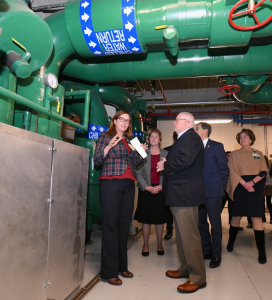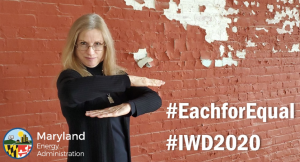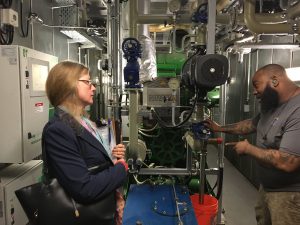Women in Maryland Energy – Q & A with Margaret “Meg” Cefail
Name: Margaret (Meg) Cefail
When did you start working with the Maryland Energy Administration (MEA)?
August 2017
Where did you work before MEA?
I was a small business owner for 8 years. I designed and managed an independent kiosk-style coffee shop located in a Baltimore business park. As part of our business, several “green” policies were implemented: The shop was designed using environmentally friendly materials (natural wood cabinetry, granite counters, ultra-low VOC paints), we locally sourced artisanal coffee and high-quality baked goods, recycled and composted whatever materials/food could be recycled and composted resulting in several hundred cubic feet of otherwise disposable material and several tons of otherwise disposed coffee grinds and foods being diverted from landfills, as well as being converted to natural fertilizer, respectively. Additionally, we encouraged the reuse of drink cups by offering discounts on beverage prices for their reuse. We were successful in growing a local business established during the latest recession and during a time when approximately half of new food establishments failed within two years.
Describe the work you do now:
I work principally with Marylanders who are seeking residential clean energy rebates for installing renewable and/or energy-efficient technologies, such as solar PV and solar water heating systems, geothermal systems, and wood/pellet stoves, as well as residential and commercial electric vehicle supply equipment rebates for electric vehicle charging systems. I also work with our combined heat and power (CHP) program manager by assisting with application reviews, quarterly reporting follow up and responding to CHP grantee requests for assistance. Learn more about how University of Maryland Medical Health Systems are using CHP here.

BWMC’s Laura Kautz explaining the to Governor Hogan how the CHP powers the hospital to run efficiently year round photo credit Maryland GovPics
What is the most challenging part of your job?
Often our applicants have difficulty securing all of the information needed to accurately complete their applications such that they can legitimately receive their rebates. I get a lot of satisfaction out of employing resourceful methods to assist our applicants secure this information and being able to deliver the good news that they have been approved for their rebates. I’ve even been able to discern when they are actually eligible for more than the requested rebate amounts. Of course, that’s the easy part. The challenge is when I need to deliver less desirable news. There’s an art to letting people down such that they still have respect for the state system.
Do you have a favorite energy generation source?
Well, any cleaner, greener or more efficient energy generating source is pretty exciting. However, from the time I first heard about combined heat and power (CHP) (known earlier as cogeneration) it struck me as a great way to capture and utilize what power generating equipment was already producing – all that waste heat! It’s great knowing that energy costs can be dramatically reduced for our grantees through use of waste heat for hot water or other heating (as well as cooling as I later learned). Also great is knowing that our grantees enjoy significantly enhanced system resilience! Click here to see Meg’s visit to our CHP grantee, Doctor’s Community Hospital last April.
Share a new energy fact you have learned while working at MEA:
You can actually use heat to cool through the use of absorption chillers! Although I knew about waste heat capture for heating purposes, I didn’t know this until I started working with our agency’s CHP program.
Tell us what you find most inspiring about the energy sector or your work:
As noted above, I’d been inspired in a previous life to reduce my company’s negative impact on the environment through good facility design, local product sourcing, reuse, recycling and composting. When I decided to make a career change, it was exciting to find an opportunity to work for an agency that also worked to achieve positive results for the environment by encouraging the installation of renewable and efficient energy production.
What should the public know about MEA?
That the wide variety of programs benefit nearly all Marylanders, either directly through rebates or grants that help offset the costs of their projects, or indirectly because of the cleaner air they breathe.
Special thanks to Meg for taking this interview.



 1-888-373-7888
1-888-373-7888 233733
233733